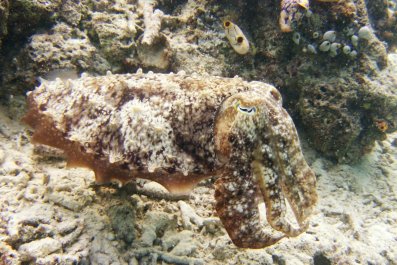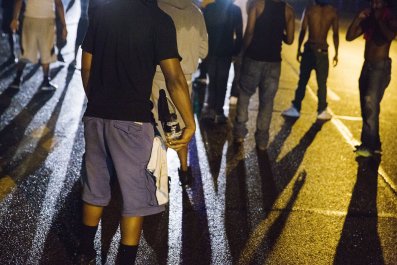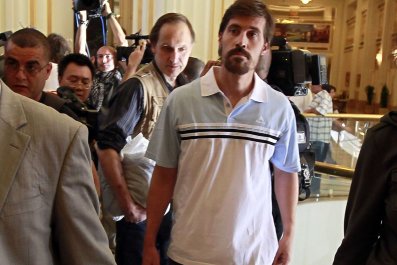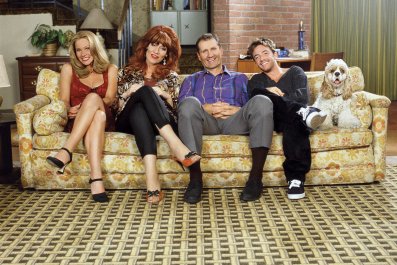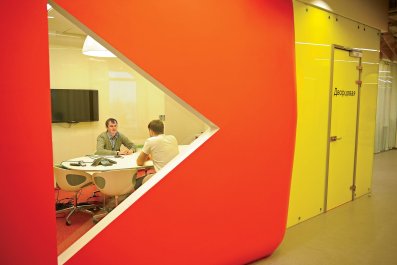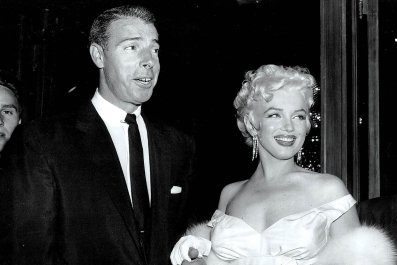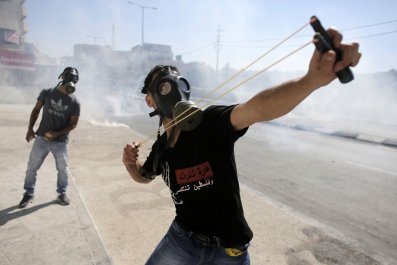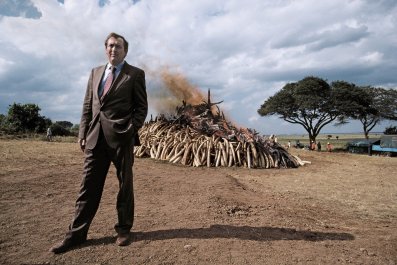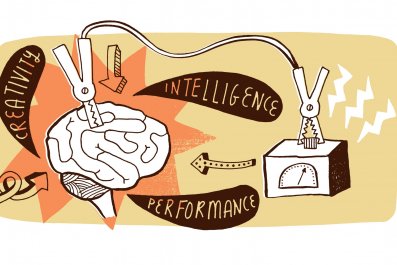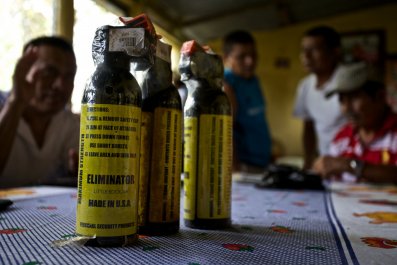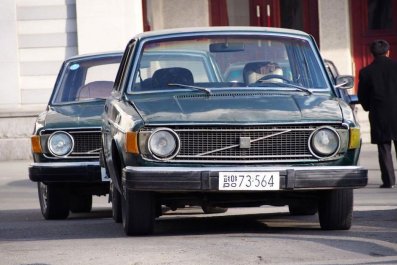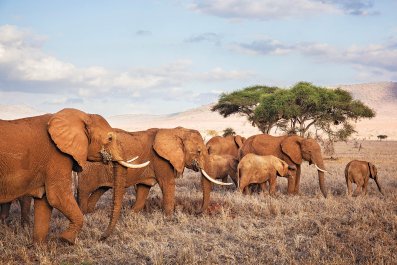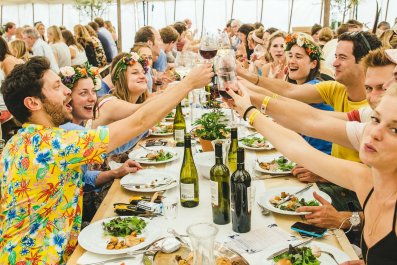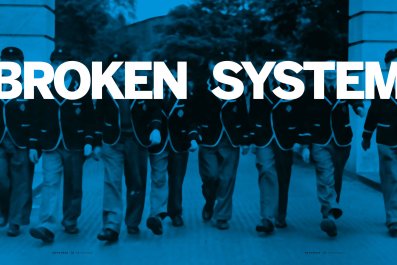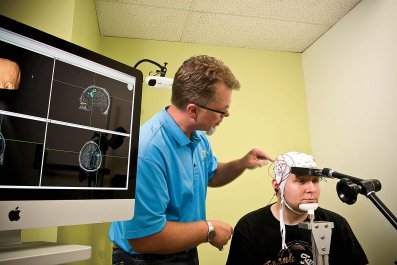Late at night, in the basement of her modest home on New York's Long Island, Marie Carmel Charles prepares to be possessed by a mermaid.
A mambo, or high priestess, in Haitian voodoo, Charles has gathered 18 of her younger initiates for a traditional, intensely private ritual called the Feeding of the Kolye, a tribute to the lwas (spirits) of the church and a celebration of several members' recent inductions into the religion. The newcomers range in age from their mid-20s to mid-40s; they are mostly African-American and Caucasian and wear pristine white garments. They chant Creole prayers fluidly back to Charles in a rapid, reverential call-and-response. They cry "ayi bobo"—a sort of "amen"—constantly.
Charles, an imposing, gracious black woman who appears to be about 60, kneels in front of the seated group, facing an altar cluttered with tall, multicolored candles, beaded bottles and a large frosted cake, among other offerings to the lwas. She keens in prayer, furiously ringing a tiny handbell. Her "godchildren" rise and collect clusters of ceremonial beaded ropes, draping them across their torsos, and begin lively, synchronized dancing. Marie splashes heavy, honeyed perfume on them as they dance.
As the chanting reaches a crescendo, the initiates spread a sheet on the concrete floor, and Charles lies on it. Her eyes roll back in her head; she is expressionless for a few minutes, then brightens, smiling up at the group, giggling and batting her hands coquettishly—behavior that is worlds away from her crisp demeanor of the past three hours. She does not speak or rise from the ground; her feet flutter. The men lie down to greet her as she pantomimes affection; one gives her a thin metal ring.
"La Sirene is inside her," Yora Mitsakos, a 41-year-old initiate and train operator, whispers to me from the perimeter of the group, referring to the mermaid deity of their faith. "This spirit is very flirty." She points to the ring being exchanged. "Sometimes when she visits, she asks commitment and marriage from the men."
After 10 minutes, Charles bolts upright and hunches over, cloudy-eyed and sputtering as she desperately sips proffered water. This signifies her soul's return to her body. In Haitian voodoo custom, this spiritual merging is a high honor, and such ceremonies occur with the same orthodoxy in the homes of believers around the world.
"People think voodoo is about sticking pins in dolls and cursing people, but neither are true," explains Ryan Anderson, who participated in the ritual, a few days later. The affable IT manager from Texas traveled to Haiti three years ago to become a houngan (the male equivalent of a mambo). "Voodoo is such a misunderstood tradition, but a beautiful one."
Despite its reputation for vengeful hexes and black magic, Haitian voodoo is a peaceful and generally optimistic religion. It encourages strong family and community bonds and regular offerings to the thousands of spirits who aid all aspects of life, from business deals to romances.
Haitian voodoo has a largely stable religious community in New York City, but its true American epicenter remains in New Orleans. Since the 16th century, the Crescent City's distinct culture has been as bound to this enigmatic belief system as it is to jazz, Mardi Gras and gut-busting Cajun cooking. And in New Orleans, a voodoo community long under duress is finally making great strides to repair itself and reclaim its soul.
You Do Voodoo?
"The voodoo tradition is of interest to most people who come to New Orleans," says Anna Eden Parmelee, owner of Erzulie's Authentic Voodoo store, "because the entire cornerstone of our culture is based on it."
Voodoo's presence in New Orleans is most prominently seen in the many dedicated shops in the French Quarter. To enter these stores, especially after dark, is to be greeted with a dizzying number of totems and promises—a mixture of the foreboding (skulls, carved knives, books of spells) and the sensual (flowing scarves, silver pendants, scented oils). The most conspicuous is Marie Laveau's House of Voodoo, which is located on a particularly raucous block of Bourbon Street and pushes its own line of charms and amulets inspired by the 17th century celebrity priestess. The Erzulie's Authentic Voodoo and Voodoo Authentica shops, on quieter roads, sell herbs, charms and other supplies to local practitioners, but also devote shelf space to handmade dolls that purportedly bring wealth, marriage, security and fertility.
Locals estimate there were 2,500 to 3,000 voodoo practitioners in New Orleans before Hurricane Katrina, which ravaged the poor, voodoo-heavy neighborhoods of the city, especially the Ninth Ward, forcing residents to relocate permanently across the country and leaving fewer than 300 practitioners in the voodoo community. Many shops went out of business.
Now, nine years after that storm, there are approximately 350 to 400 active practitioners, split between the two dominant strains, Haitian and New Orleans. Haitian voodoo (or vodou) draws from elements of Roman Catholicism, dating back to the 16th century trans-Atlantic slave trade and the unrest (and ultimately a slave rebellion) in Haiti. New Orleans voodoo (also called Louisiana voodoo) embraces voodoo queens, gris-gris (talismans, which Laveau made a tidy living selling) and other non-Haitian concepts. (New Orleans also has the smaller, ancillary communities of Santería, a more Hispanic-influenced West African and Caribbean faith, and Candomblé, an Afro-Brazilian religion with many similarities to Haitian voodoo.)
Both strains of voodoo are monotheistic (the highest god is Bondyè, the "good lord"), are mostly oral- instead of text-based and celebrate thousands of cosmic and natural spirits (akin to Catholicism's saints). Participants are, and historically have been, mostly lower-income. Creoles and local slaves in the 18th century followed aspects of voodoo; so did slaves in pre-Civil War New Orleans during their Sunday dances at Congo Square. Voodoo influence grew stronger during the Haitian Revolution of 1791, when thousands of Africans and Haitians immigrated to the city. The earliest roots of voodoo date back approximately 6,000 years to Benin, West Africa, and an estimated 60 million people practice it worldwide.
Before Katrina, Haitian voodoo and New Orleans voodoo believers segregated themselves; while civil, they did not overlap often in parties or services. "There was more raw competition before Katrina—human stuff like 'What I'm doing is more authentic,'" says Sallie Ann Glassman, the most visible mambo in New Orleans. She runs the Island of Salvation Botanica shop, is a regular lecturer on vodou and wrote the book Vodou Visions. "But those people left after the storm."
After Katrina, the remaining members began to forge a new, cross-faith community. The mixed ceremonies and social gatherings served a support network for participants from both sides of voodoo as they rebuilt their lives. "We became more close-knit. Those of us who stayed and didn't evacuate opened what lines of communication had been closed," says Michael "Belfazaar" Bousum, an employee of Voodoo Authentica and a priest of New Orleans voodoo.
The new scene has also encouraged members of the ancient religion to create a web presence—forums such as "Vodou, Voodou, Vodoun, Vodun" on Facebook and "A Real Voodoo Club" on Yahoo Groups are popular—as well as welcoming outsiders to their events for the first time. "Before, you really would have had to know who a mambo or a houngan was to participate in a public or private ceremony. You would have to be in the inner circle. Now it's accessible with a few keystrokes," says Parmelee. "Plus, people who left are returning. The community is definitely coming back."
The Bigger, Easier
Tourism is rebounding in New Orleans. The city took in $6.47 billion in visitor spending in 2013—the largest in the city's history, according to Mark Romig, president and CEO of the New Orleans Tourism Marketing Corp. "There are a few reasons: an increase in the number of festivals, an increase in the number of restaurants and visitors are staying longer," says Romig. This past year, two popular TV series,True Detective and American Horror Story: Coven, were based in the city (the latter incorporated a fictionalized version of Marie Laveau into its storyline). This rise in visitor interest is bolstering stores that struggled to stay open after the storm.
The city's burgeoning arts scene is also spurring new interest in voodoo. Morgan Molthrop, the owner of a tour company for corporate groups called Custom Conventions, says his clients have shown "increasing interest" in voodoo in the past year. "One thing changing here is the visual arts scene, and I see a seamlessness between the visual arts and the people who've moved into that neighborhood [the Marigny]. And in that area is the New Orleans Healing Center."
The 55,000-square-foot spiritual center and community complex is the most prominent symbol of voodoo's resurgence in the city. Opened in 2011 at a cost of almost $13 million (from public and private funding), the center includes a voodoo shop and hosts public vodou ceremonies. Its interior borrows heavily from vodou, including a La Sirene-style mermaid sculpture in the lobby, which plays prominently into the center's annual Anba Dlo ("Beneath the Waters") Festival, which honors both the vodou belief that humanity comes from water and the city's rebuilding post-Katrina.
"Putting together the Healing Center has been a whole process of getting [outsiders] comfortable and tolerant with being associated with voodoo. A lot of people who feared it turned around," says Glassman. "There's a much greater respect for the religion now, an acceptance that it is a religion."
The new closer-knit voodoo community is not without its drawbacks, though; its small size is allowing fundamentalist conflicts to draw more attention than they would in a larger group. This is especially noticeable in Haitian voodoo; in the past few years, there's been an upswing in friction between younger Haitian initiates and older members over what is deemed acceptable "purity" of their faith.
"I have noticed that a lot of the Americans going to Haiti to get initiated come back and have rookie newbie syndrome," says Brandi Kelley, owner of Voodoo Authentica. "They tend to have this zeal, an [attitude] of 'Here's how you should be doing things.' These [new people] don't get the welcoming, inclusive part of voodoo; they seem to equate the word purity with exclusion."
Such hostility is the exception to the rule of the warmer and generally familial community, Kelley stresses, but it is starting to breed hostility—an echo of the more fragmented scene before Katrina. Matt Deos, who moved to New Orleans this spring, is all too familiar with this sort of suspicion. "The moment that these people down here learn that I'm an initiate on the Haitian side, it's like all their defenses go up. They think I'm gonna attack," says Deos, who calls himself a "hardcore traditionalist" practitioner. "They think I'm gonna say, 'Your practice isn't valid.' All this stuff comes out."
This infighting will not derail the resurgence of voodoo in New Orleans, says Priestess Miriam, who presides over the colorful, gris-gris-laden New Orleans Voodoo Spiritual Temple. Miriam is one of the most high-profile matriarchs in New Orleans voodoo; she once served as a spiritual guide to Nicolas Cage, even traveling to Hawaii to perform a blessing on his wedding to Lisa Marie Presley in 2002.
Voodoo practitioners are hardy souls, Miriam explains, whether they live in New Orleans, New York or anywhere else in the world. "We always rise up," she says, "and see the light of the day."




